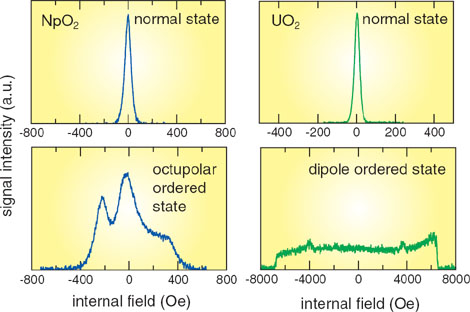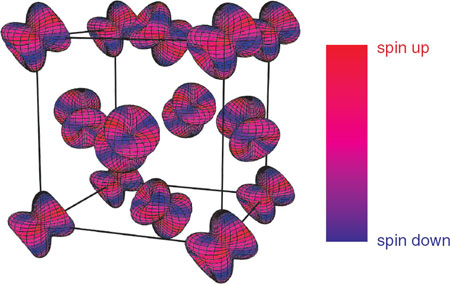Neptunium dioxide (NpO2) and uranium dioxide (UO2) are among the most studied actinide compounds. However, until recently the electronic state of NpO2 at low temperatures (the ground state) had remained a mystery. In recent work, the possibility that this ground state can be described as one of a new class of magnetically ordered states associated with the orbital degrees of freedom has been discussed. With this in mind, we have tackled this problem anew using advanced experimental and theoretical techniques. We have obtained results which strongly suggest the ground state to be an ordered state of magnetic octupoles, instead of the usual magnetic dipoles.
For experimental studies, we have used nuclear magnetic resonance (NMR), which offers a microscopic probe of the electronic state of such a system [1]. To do such NMR measurements, we have prepared an 17O- enriched NpO2 sample, leading to the first observation of 17O-NMR signals in this compound (Fig. 7-1). Furthermore, from our analysis of the data, we have shown that the hyperfine fields at the oxygen sites can be clearly understood in terms of the ordering of magnetic octupoles and electric quadrupoles, which are found to display a unique triple-q structure.
We have thrown additional light on this problem by developing a microscopic theory [2]. Np ions form an fcc lattice in NpO2, and we have analyzed an f-electron model on an fcc lattice. We have found that the lowest energy state (ground state) has magnetic octupole moments pointing in four different directions, as illustrated in Fig. 7-2. The origin of the octupolar ordering in NpO2 has been identified by this microscopic theory.
It is only recently that the importance of the multipole degrees of freedom, including those associated with octupoles, have come to be widely recognized in the study of condensed matter physics. If octupole order is proved to hold in NpO2, it will become the first such case. A complete picture of the ordered state of NpO2, which has been a mystery for over half a century since its discovery in 1953, is expected to be achieved in the near future. |

